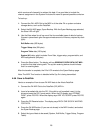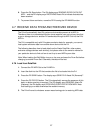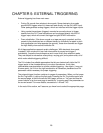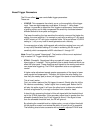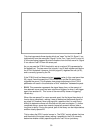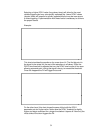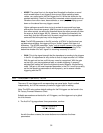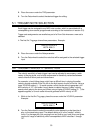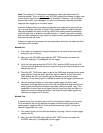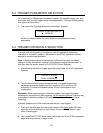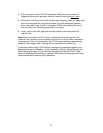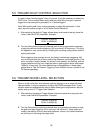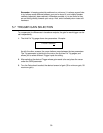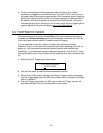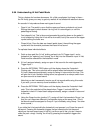
34
Note: The setting of 0, Unassigned, is selected by rotating the Data wheel fully
counterclockwise. This is a special case VCURVE setting which allows a trigger input
to contribute to the D4’s master suppression threshold. However, it will not trigger
any sounds or MIDI note messages. In certain circumstances this setting can help
suppress false triggering on the other inputs.
Example: Suppose three drum pads are mounted on a single drum stand while set
up on a noisy stage. Normally, a higher XTALK setting would be used to eliminate
interaction between the pads, and a high NOISE floor setting would be selected to
reject the high level of ambient noise and vibration. In certain cases with crosstalk
and noise floor settings too high, softer hits might become rejected because the D4
assumes that they are noise.
Instead of compromising between the two parameters, there are two methods which
can improve this scenario.
Method One:
1. First, attach an inexpensive contact transducer to the center of the drum stand
and plug it into a D4 input.
2. Next, go to the VCURVE page under the EXT TRIG function and select the
VCURVE setting of 0 (Unassigned) for this trigger.
3. Go to the next page and set the XTALK, DCAY and the NOISE levels all to 00.
This low level will allow the maximum amount of noise and stand vibrations to be
detected by the D4.
4. Press the EXT TRIG button again to get to the GAIN page showing the bar graph
meter display. Using the meter, adjust the level to select a "hotter" than usual
GAIN setting. Since in this case the gain is effected only by the the stand
vibrations, a very strong signal is needed to maximize the trigger's performance.
5. Now as the stage vibrates, or when other signals trigger the drum stand
transducer, the suppression function will note this signal and determine that any
softer signals coming from the other three pads must be crosstalk. Also, if the
suppression function sees a soft signal from the three main pads but little or no
signal from the drum stand transducer, it will assume that the pad signals are
valid hits and trigger the D4 sounds.
Method Two:
In severe cases, this is another way in which the Unassigned feature can be used.
For this scenario lets use the bass as the reason the surrounding noise level is
making proper triggering difficult. Each time the bass player "pops" a string, the
vibration triggers the tom 1 pad.
1. First, take a direct out from the bass amplifier, and plug it into an unused trigger
input on the D4.
2. Next, go to the VCURVE page under the EXT TRIG function and select the
VCURVE setting of 0 (Unassigned) for this trigger.



